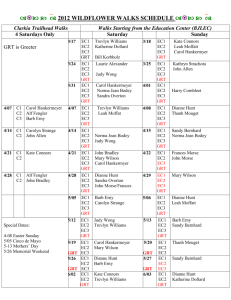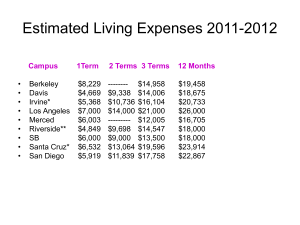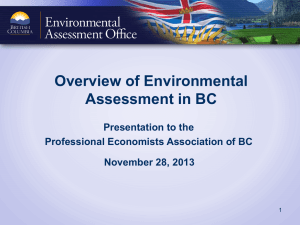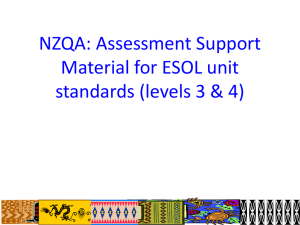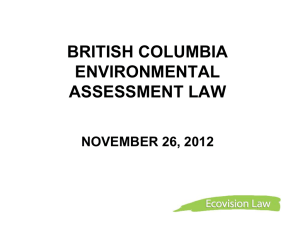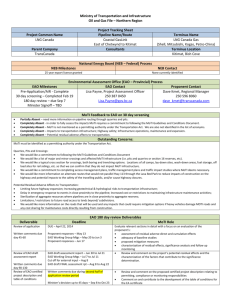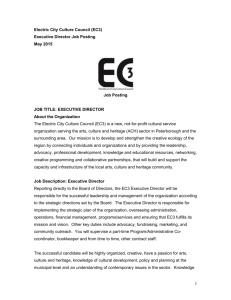X - ORT Braude College
advertisement
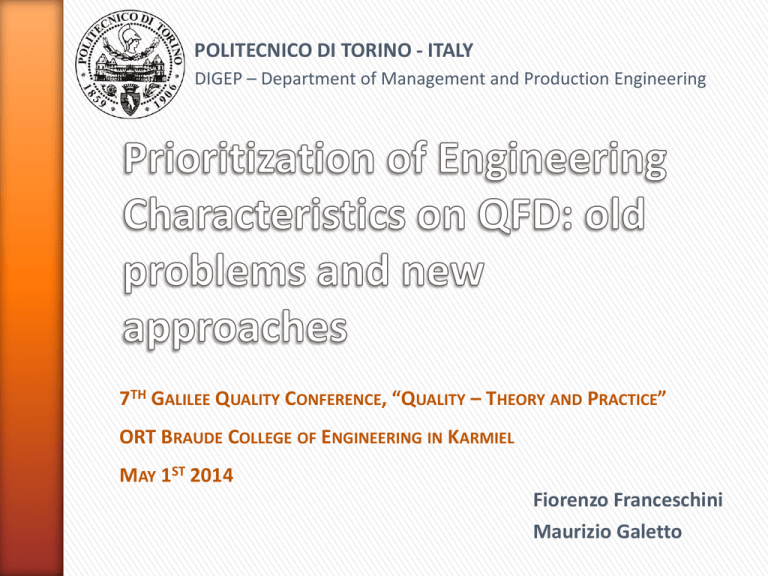
POLITECNICO DI TORINO - ITALY
DIGEP – Department of Management and Production Engineering
7TH GALILEE QUALITY CONFERENCE, “QUALITY – THEORY AND PRACTICE”
ORT BRAUDE COLLEGE OF ENGINEERING IN KARMIEL
MAY 1ST 2014
Fiorenzo Franceschini
Maurizio Galetto
“QFD is a method to transform user demands into
design quality, to deploy the functions forming
quality, and to deploy methods for achieving the
design quality into subsystems and component
parts, and ultimately to specific elements of the
manufacturing process”.
Akao (1988)
2
I like …
I like …
I want …
I wa I want …
I like .
I want …
I want …
I want …
I like …
NEW PRODUCT
CUSTOMERS
COMPANY
3
QFD PLANNING STRUCTURE
Phase IV
Phase III
Phase II
Phase I
PROCESS PLANNING
MATRIX
PART / SUBSYSTEM
DEPLOYMENT MATRIX
PRODUCT
PLANNING MATRIX
Customer
Customer
Requirements
requirements
PROCESS / QUALITY
CONTROL MATRIX
Critical
Engineering
Product
Characteristics
Requirement
Critical
Components
Characteristics
Critical
Process
Step
Process &
Quality Control
Parameters
Critical
Process
Steps
Critical
Components
Characteristics
Critical
Engineering
Product
Characteristics
Requirement
4
2. Prioritization of Customer
Requirements
1. Customer Requirements
6. Relationship Matrix
4. Competitive Prioritization of
Customer Requirements
3. Competitive Benchmarking
7. Correlation
Matrix
5. Engineering Characteristics
8. Prioritization of Engineering
Characteristics
5
•
•
•
•
•
Easy to hold
Does not smear
Point lasts
Does not roll
…
6
Customer
Requirements
Engineering
Characteristics
f
QFD
work
group
L
•
•
•
•
hexagonality,
erasure residue,
dust,
…
7
Customer Requirements
(CRs)
Easy to hold
Does not smear
Point lasts
Does not roll
Engineering Characteristics
(ECs)
•
•
•
•
•
•
•
•
•
•
•
length
hexagonality
time between sharpening
lead dust generated
erasure residue
length
time between sharpening
lead dust generated
erasure residue
length
hexagonality
8
Does not smear
Point lasts
Does not roll
Erasure residue
Hexagonality
O
Lead dust
generated
Easy to hold
Time between
sharpening
Customer Requirements
(WHATS)
Length
Engineering Characteristics
(HOWS)
X
O
X
X
O
X
X
X
-> weak relationship
O -> medium relationship
X -> strong relationship
9
• CRs prioritization (are all CRs equally
important?)
• ECs prioritization.
10
Easy to hold
3rd
Does not smear
2nd
Point lasts
1st
Does not roll
3rd
O
Erasure residue
Hexagonality
Lead dust
generated
Time between
sharpening
Length
Customer Requirements
(WHATS)
Priorities of
WHATS
Engineering Characteristics
(HOWS)
X
O
X
X
O
X
X
X
Priorities of HOWS
Can CRs prioritization influence
ECs prioritization?
11
Steps:
1. assign a numerical importance to each CR;
2. convert the relationships symbols between
CRs and ECs into “equivalent” numeric
values;
3. determine the numerical importance of
each EC using the ISM algorithm.
12
Does not smear
3
Point lasts
5
Does not roll
2
1
2
3
4
5
->
->
->
->
->
not important at all
minor importance
some importance
strong importance
very strong importance
Erasure residue
O
Hexagonality
2
Lead dust
generated
Length
Easy to hold
Customer Requirements
(WHATS)
Time between
sharpening
Importance of
WHATS
Engineering Characteristics
(HOWS)
X
O
X
X
O
X
X
X
13
Importance of
WHATS
Length
Time between
sharpening
Lead dust
generated
Hexagonality
Erasure residue
Engineering Characteristics
(HOWS)
Easy to hold
2
3
0
0
9
0
Does not smear
3
0
3
9
0
9
Point lasts
5
1
3
9
0
9
Does not roll
2
1
0
0
9
0
Customer Requirements
(WHATS)
empty box -> 0
-> 1
O -> 3
X -> 9
14
Importance of
WHATS
Length
Time between
sharpening
Lead dust
generated
Hexagonality
Erasure residue
Engineering Characteristics
(HOWS)
Easy to hold
2
3
0
0
9
0
Does not smear
3
0
3
9
0
9
Point lasts
5
1
3
9
0
9
Does not roll
2
1
0
0
9
0
13
24
72
36
72
Customer Requirements
(WHATS)
Priorities of HOWS
w1 2 3 3 0 5 1 2 1 13
w2 2 0 3 3 5 3 2 0 24
w2 ...
n
w j di ri , j
i 1
15
•
•
•
•
•
•
Intuitional.
Easy to use.
Easy to interpret.
Use of standard Mathematical operators.
Largely diffused.
…
16
• Are customers really able to express
CRs importance on ratio scales
(cardinal properties)?
• What is the correct symbol
codification in the relationship matrix
(1-2-3, 1-3-5, 1-3-9, …)?
• How to select the right scale for
importance and symbol codification?
• Is there any arbitrariness in scale
definition (zero point, graduation,
unit, …)?
17
All CRs have the same importance d = 1.
EC1
EC2
EC1
EC2
CR1
X
X
CR1
X
X
CR2
X
CR2
X
CR3
O
X
CR3
O
X
CR4
O
CR4
O
CR5
O
CR5
O
CR6
O
CR6
O
Importance
18
Importance
22
15
Codification 1-3-5
Codification 1-3-9
EC1 > EC2
EC1 < EC2
27
18
• The response scale has ordinal properties:
Scale level
1
2
Description
Not important at all
Minor importance
3
4
5
Some importance
Strong importance
Very strong importance
• Arbitrary promotion of results from ordinal
to interval or ratio scales.
19
3
1
2
3
4
5
2
1
2
3 4
5
5
1 23
4
5
Can we sentence that the mean value of the
3 2 5 10
sample is x
?
3
3
20
CRs
CR1
CR2
1
2
X
3
4
5
X
CR3
X
We can sentence:
• CR1 is better than CR2
We cannot sentence:
• CR1 is evaluated twice CR2 (ratio scale)
• the distance between CR3 and CR1 is 3 scale
units (interval scale).
21
• Respondents’ orderings:
1) CR3 > CR1 > CR2
2) CR1 > CR2 > CR3
3) ...
• How operate a fusion of respondents’
orderings?
22
2. Prioritization of Customer
Requirements
1. Customer Requirements
6. Relationship Matrix
4. Competitive Prioritization of
Customer Requirements
3. Competitive Benchmarking
7. Correlation
Matrix
5. Engineering Characteristics
8. Prioritization of Engineering
Characteristics
23
• In the scientific literature there are many
approaches for prioritizing CRs.
• Some of them may lead to misleading results.
• In some cases we assist to a
violation of scale properties
on which CRs are evaluated.
24
• The AHP is a technique of Multiple Criteria
Decision Making developed by Thomas L.
Saaty (1980).
• It is based on the paired comparison of CRs.
• The result is a global ordering of the CRs.
25
PAIRED COMPARISON MATRIX
a12
1
1/ a
1
12
A
...
...
1/ a1n 1/ a2n
... a1n
... a2n
... ...
... 1
d1 / d1
d / d
2 1
dn / d1
d1 / d2
d2 / d2
dn / d2
d1 / dn
d2 / dn
dn / dn
A d max d
d1
d
dn
PRIORITY
VECTOR
26
CR1 (Easy to hold)
CR2 (Does not smear)
CR3 (Point lasts)
CR4 (Does not roll)
CRs Importance
1
5
6
7
0.61
CR2 (Does not smear)
1/5
1
4
6
0.24
CR3 (Point lasts)
1/6
1/4
1
4
0.10
CR4 (Does not roll)
1/7
1/6
1/4
1
0.05
CR1 (Easy to hold)
27
• Not always the consistency of paired
comparisons is guaranteed.
• Respondents usually do not have a common
reference scale.
• It is based on the assumption that Saaty’s
scale for paired comparison has ratio scale
properties.
• It is “effective” only with small numbers of
CRs.
28
• It may lead to inconsistencies in judgment.
Example:
If CR1 > CR2 and CR2 > CR3 , it can happen for
some individuals that CR3 > CR1 .
29
2. Prioritization of Customer
Requirements
1. Customer Requirements
6. Relationship Matrix
4. Competitive Prioritization of
Customer Requirements
3. Competitive Benchmarking
7. Correlation
Matrix
5. Engineering Characteristics
8. Prioritization of Engineering
Characteristics
30
The scientific literature proposes many
techniques which differ for:
• typology of data,
• properties of data and scales,
• mathematical models for
synthesis/aggregation of the information
collected from the customers (mean,
median, standard deviation, …),
• models linking CRs and ECs in the
relationship matrix (linear, weighted, …).
31
• Independent Scoring Method (ISM) [Akao, 1988],
• Multiple Criteria Decision Aid (MCDA) methods
(Electre II, …) [Roy, 1991].
• Interactive Design Requirement Ranking (IDRR)
algorithm [Franceschini, 2002].
• Paired Comparison Method (PC) [Thurstone,
1927].
• Ordinal Prioritization Method (OPM)
[Franceschini, 2014].
• ...
32
Independent
Scoring Method
(ISM)
Ordinal
Prioritization
Method (OPM)
Multiple Criteria
Decision Aid
(MCDA)
Interactive Design
Requirement
Ranking (IDRR)
Paired
Comparison
Method (PC)
33
Coefficients of Relationship matrix
CRs importance
cardinal scale
ordinal scale
cardinal
scale
Independent
Scoring Method
(ISM)
Thurstone scaling
+
Independent
Scoring Method
(ISM)
ordinal
scale
Thurstone scaling
Multiple Criteria
+
Decision Aid
Multiple Criteria
(MCDA) methods
Decision Aid
(MCDA) methods
ordering
Ordered
Weighted
Averaging (OWA)
ordering
Ordinal
Prioritization
Method (OPM)
34
• It is a variant of Yager’s algorithm (2001).
• Each EC is evaluated according to any CR, a
preference vector corresponding to each
CR can be defined.
• There are 3 fundamental phases:
1. Construction and reorganization of
decision-makers’ preference vectors.
2. Definition of the reading sequence.
3. Generation of the fused ordering.
35
Reorganized vectors for the pencil example (CR3 > CR2 > CR1 CR4)
CR3
CR2
CR1CR4
{EC3,EC5}
{EC2}
{EC1}
{EC3,EC5}
{EC2}
Null
{EC4,EC4}
{EC1}
{EC1}
{EC4}
{EC1,EC4}
{EC2,EC2,EC3,EC3,EC5,EC5}
36
The ordering algorithm
Pass
Element (I)
Cumulative Occurrences (Ok)
Residual elements (R)
Gradual Ordering
EC1
EC2
EC3
EC4
EC5
(Tk = 1)
(Tk = 1)
0
-
0
0
0
0
0
{EC1, EC2, EC3, EC4, EC5}
-
1
{EC3,EC5}
0
0
1
0
1
{EC1, EC2, EC4}
EC3 EC5
2
{EC3,EC5}
0
0
2
0
2
{EC1, EC2, EC4}
EC3 EC5
3
{EC4,EC4}
0
0
2
2
2
{EC1, EC2}
EC3 EC5 > EC4
4
{EC2}
0
1
2
2
2
{EC1}
EC3 EC5 > EC4 > EC2
5
{EC2}
0
2
2
2
2
{EC1}
EC3 EC5 > EC4 > EC2
6
{EC1}
1
2
2
2
2
-
EC3 EC5 > EC4 > EC2> EC1
7
{EC1}
2
2
2
2
2
-
EC3 EC5 > EC4 > EC2> EC1
8
Null
2
2
2
2
2
-
EC3 EC5 > EC4 > EC2> EC1
9
{EC1}
3
2
2
2
2
-
EC3 EC5 > EC4 > EC2> EC1
10
{EC4}
3
2
2
3
2
-
EC3 EC5 > EC4 > EC2> EC1
11
{EC1,EC4}
4
2
2
4
2
-
EC3 EC5 > EC4 > EC2> EC1
12
{EC2,EC2,EC3,EC3,EC5,EC5}
4
4
4
4
4
-
EC3 EC5 > EC4 > EC2> EC1
FINAL ORDERING
37
• Ordered Weighted Average (OWA)
emulator of arithmetic mean was first
introduced by Yager (1993).
• This operator is typically used with
ordinal scales.
SAMPLE SIZE
LINGUISTIC QUANTIFIER
ORDERED ELEMENT
OF THE SAMPLE
OWA Max MinQ k , bk
n
k 1
38
Does not smear
S3
Point lasts
S5
Does not roll
S2
S1
S2
S3
S4
S5
->
->
->
->
->
not important at all
minor importance
some importance
strong importance
very strong importance
Erasure residue
O
Hexagonality
S2
Lead dust
generated
Length
Easy to hold
Customer Requirements
(WHATS)
Time between
sharpening
Importance of
WHATS
Engineering Characteristics
(HOWS)
X
O
X
X
O
X
X
X
-> weak relationship
O -> medium relationship
X -> strong relationship
39
• Q k S f k , k 1,2,..., n is the average linguistic
quantifier (the weights of the OWA operator),
t 1
with f k Int 1 k
;
n
• S f k is the f(k)-th level of the linguistic scale (for
example Sf(k) = S1 if f(k) = 1);
• Int(a) is a function which gives the integer
closest to a;
• t is the number of scale levels;
• n is the sample size.
40
• Number of scale levels: t = 5 (S1, S2, S3, S4, S5).
• Sample size: n = 10.
• Ordered elements: S5, S5, S5, S4, S4 , S3, S3, S3, S2, S1.
• The weights are:
Q(1) = S1,
Q(2) = Q(3) = S2,
Q(4) = Q(5) = Q(6) = S3,
Q(7) = Q(8) = S4,
Q(9) = Q(10) = S5.
41
OWA= Max MinS1 , S5 ,MinS2 , S5 ,MinS2 , S5 ,MinS3 , S4 ,MinS3 , S4 ,
MinS3 , S3 ,MinS4 , S3 ,MinS4 , S3 ,MinS5 , S2 ,MinS5 , S1 S3
42
Thank you for your
attention!
… any questions?
43
• Rossetto S., Franceschini F., “Quality and innovation: A conceptual
model of their interaction”, Total Quality Management, v. 6 n. 3,
1995, pp. 221-229.
• Franceschini F., Rossetto S., “The problem of comparing
technical/engineering design requirements”, Research in
Engineering Design, v. 7, 1995, pp. 270-278.
• Franceschini F., Rossetto S., “Design for Quality: selecting product's
technical features”, Quality Engineering, v. 9, n. 4, 1997, pp. 681688.
• Franceschini F., Zappulli M., “Product's technical quality profile
design based on competition analysis and customer requirements:
an application to a real case”, International Journal of Quality and
Reliability Management, v. 15, n. 4, 1998, pp. 431-442.
44
• Franceschini F., Rossetto S., “QFD: how to improve its use”, Total
Quality Management, v. 9 n. 6, 1998, pp. 491-500.
• Franceschini F., Terzago M., “An application of Quality Function
Deployment to industrial training courses”, International Journal of
Quality and Reliability Management, v. 15, n. 7, 1998, pp. 753-768.
• Franceschini F., Rupil A., “Rating scales and prioritization in QFD”,
Total Quality Management, v. 16, n. 1, 1999, pp. 85-97.
• Franceschini F., Rossetto S., “QFD: an interactive algorithm for the
prioritization of product's technical characteristics”, Integrated
Manufacturing Systems, v. 13, n. 1, 2002, pp. 69-75.
• Franceschini F., Advanced Quality Function Deployment, St. Lucie
Press/CRC Press LLC, Boca Raton, FL, 2002.
45
• Franceschini, F., Galetto, M., Varetto, M., “Qualitative ordinal
scales: the concept of ordinal range”, Quality Engineering, v. 16, n.
4, 2004, pp. 515-524.
• Franceschini, F., Galetto, M., Varetto, M., “Ordered samples control
charts for ordinal variables”, Quality and Reliability Engineering
International, v. 21, n. 2, 2005, pp. 177-195.
• Franceschini, F., Brondino, G., Galetto, M., Vicario, G., “Synthesis
maps for multivariate ordinal variables in manufacturing”,
International Journal of Production Research, v. 44, n. 20, 2006, pp.
4241-4255.
• Franceschini F., Galetto M., Maisano D., Management by
Measurement: Designing Key Indicators and Performance
Measurements. Springer, Berlin, 2007.
46

